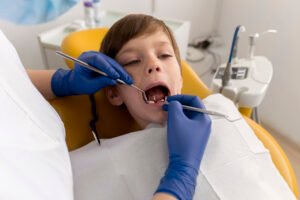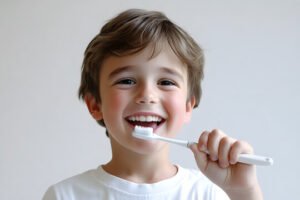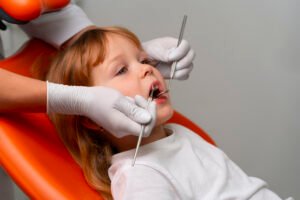A Comprehensive Guide to Selecting the Ideal Toddler Toothbrush for Optimal Oral Health
Hello Parents! Welcome to an in-depth exploration of a seemingly small yet incredibly significant aspect of your child’s early development: choosing the best toothbrush for toddlers. Remember those heartwarming, gummy smiles that once captivated your world? As those precious little teeth make their grand entrance, a new and vital routine emerges – toothbrushing! As devoted parents ourselves, deeply invested in the well-being and happiness of children, we understand your desire to provide nothing but the best for your little ones. Laying the foundation for a lifetime of radiant and healthy smiles begins right here, with the selection of that very first, perfectly suited toothbrush.
Navigating the vibrant and diverse landscape of toddler toothbrushes available today can indeed feel like a significant undertaking. Questions abound: Should you opt for soft or extra-soft bristles? Is a large handle or a small one more appropriate? Rest assured, you are not alone in this quest! Drawing upon our own experiences as parents, coupled with valuable insights generously shared by the exceptional professionals at LittlesmilesofBeverlyhills.com, we have meticulously crafted this comprehensive guide to empower you in making the most informed decision for your precious child.
The Profound Impact of a Humble Brush
Consider your toddler’s nascent oral cavity as a delicate and burgeoning garden. Just as a gardener requires the right tools to nurture tender seedlings, we too need the appropriate instrument to care for those emerging teeth and gums. An adult toothbrush, with its larger size and firmer bristles, is simply unsuitable for this delicate environment – akin to using a large, coarse rake on delicate sprouts. The specifically designed toddler toothbrush acts as the perfect miniature gardening tool – gentle yet effective, and precisely sized for those small hands and mouths. Its role extends far beyond mere cleaning; it actively contributes to:
- Maintaining the Comfort and Health of Delicate Gums: The soft bristles provide a gentle massage, promoting healthy blood flow and preventing irritation.
- Efficiently Removing Food Particles and Plaque: The appropriately sized head and bristles can effectively reach all surfaces of those tiny teeth, whisking away debris that can lead to decay.
- Encouraging Early Participation in Oral Hygiene: A comfortable and easy-to-grip handle empowers your little one to engage in the brushing process, fostering independence and positive associations.
- Ensuring Utmost Safety: Reputable toddler toothbrushes are crafted from non-toxic, BPA-free materials, prioritizing your child’s well-being.
- Transforming Brushing into an Enjoyable Experience: Engaging designs, vibrant colors, and familiar characters can shift the perception of brushing from a chore to a fun and anticipated activity.
Deciphering the Details: Key Features to Consider in a Toddler Toothbrush
Let’s delve into the specific characteristics that distinguish an excellent toddler toothbrush:
The Brush Head: Prioritizing Compactness and Reach
Envision attempting to clean the intricate interior of a tiny teacup with an oversized sponge – the task would be cumbersome and ineffective. Similarly, a large toothbrush head is ill-suited for a toddler’s small mouth. Seek out toothbrushes featuring a small, compact brush head that can effortlessly navigate the limited space and reach every surface of those developing teeth, including those tucked away at the back of the mouth.
Bristle Selection: The Importance of Gentle Softness
A toddler’s gums are exceptionally sensitive and require the utmost care. Therefore, it is paramount to consistently choose toothbrushes labeled with extra-soft or soft bristles. Bristles that are any firmer can cause irritation, discomfort, and even potentially damage the delicate enamel of newly erupted teeth. As the esteemed Dr. Sepehr Nassiripour frequently emphasizes, a gentle approach is always the most effective when it comes to young smiles.
Handle Design: Facilitating a Comfortable and Secure Grip
Tiny hands are still developing their fine motor skills, making a chunky, easy-to-grip handle an invaluable feature. Many toddler toothbrushes incorporate playful shapes or non-slip textures to enhance grip and empower your little one to participate more effectively in the brushing process.
Safety Standards: A Non-Negotiable Priority
Just as you meticulously select safe toys for your child, their toothbrush must adhere to stringent safety standards. Always ensure that the toothbrush is explicitly labeled BPA-free and constructed from non-toxic materials. Furthermore, carefully inspect the toothbrush for any small, detachable parts that could pose a choking hazard.
The Fun Factor: Injecting Excitement into Oral Care
Let’s face it, anything that can transform the act of brushing from a potential struggle into an engaging activity is a significant victory for parents! Bright colors, beloved cartoon characters, and even integrated light-up timers can pique your toddler’s interest and foster a more positive association with brushing time.
Your Personalized Guides: Simple Charts for Optimal Selection
To streamline the decision-making process, we have compiled the following user-friendly charts with our expert recommendations:
Chart 1: Finding the Right Bristle Softness by Age
| Tiny Explorer Age | Bristle Hug Level | Why This Works Best | Expert Tip from Dr. Sepehr Nassiripour & LittlesmilesofBeverlyhills.com |
| 12-24 Months | Extra-Soft Cuddles | Those first little teeth need the gentlest touch! Extra-soft bristles are like a soft massage for their new arrivals and sensitive gums. | Dr. Nassiripour and the team at LittlesmilesofBeverlyhills.com agree: starting with ultra-gentle is key to building positive brushing habits right from the start. |
| 2-3 Years | Soft & Gentle | As more teeth join the party, soft bristles can still be super effective while remaining kind to their gums. Some toddlers might prefer the slightly firmer feel of a soft bristle. | The friendly experts at LittlesmilesofBeverlyhills.com often suggest letting your little one try both extra-soft and soft to see which feels best for them, as long as it’s gentle! |
| 3+ Years | Soft Power! | With a full set of primary teeth, soft bristles are perfect for getting those pearly whites sparkling clean while still being gentle on their gums. | Even as they get older, soft bristles are still the way to go to protect that precious enamel, according to the gentle approach championed by Dr. Nassiripour. |
Chart 2: Handle Heroes: Features for Little Grippers
| Handle Feature | Why Little Hands Love It | Things to Keep in Mind | Pro Parent Tip from LittlesmilesofBeverlyhills.com |
| Chubby & Easy to Grab | Perfect for small fists to hold onto securely, giving them more control. | Might feel a tad bulky for the very youngest brushers (under 18 months). Consider their hand size when choosing. | The team at LittlesmilesofBeverlyhills.com often recommends handles with a bit of texture – it helps those little fingers get an even better grip! |
| No-Slip Superstar! | Prevents slippery situations during brushing, making it safer and more effective. | Check that the non-slip material is easy to clean – we don’t want any hidden gunk! | Dr. Nassiripour always emphasizes safety, and a good grip minimizes the chances of accidental bumps or pokes. |
| Ergonomic Explorer Shape | Designed to fit their little hand just right, making brushing more comfortable. | Different shapes might suit different hands, so if possible, let your little one have a say in what feels good. | Some ergonomic designs even encourage the right way to hold the brush, which is a bonus! |
| Character Crew Fun! | Makes brushing time exciting and ties it in with their favorite pals! | Just make sure the fun design doesn’t get in the way of a good, easy-to-hold handle. And watch out for any small, detachable bits. | The friendly folks at LittlesmilesofBeverlyhills.com know that making brushing fun is half the battle! |
Chart 3: Cool Extra Features for Brushing Brilliance!
| Awesome Add-On | Why It’s Great for Little Brushers | Something to Consider | Expert Insight from Dr. Sepehr Nassiripour & LittlesmilesofBeverlyhills.com |
| Built-in Time Tracker | Helps teach them how long to brush for (those two minutes can feel like forever to a toddler!). | Make sure the timer is simple for them to understand – flashing lights or a little tune work wonders! | Dr. Nassiripour finds timers to be super helpful in establishing good brushing habits and ensuring they’re cleaning thoroughly. |
| Suction Cup Stand | A neat and tidy way to store their brush, keeping it off the counter and away from germs. | Might not stick to all bathroom surfaces perfectly, so test it out! | The team at LittlesmilesofBeverlyhills.com thinks this is a fun way for toddlers to “park” their toothbrush after a job well done! |
| Tongue-Tidying Tool | Encourages a clean sweep of the tongue for extra fresh breath. | Might be a bit tricky for very young toddlers to master, so introduce it gently as they get older and more coordinated. | While a great addition, Dr. Nassiripour advises focusing on good tooth brushing first and adding tongue cleaning when they’re ready. |
Visualizing Growth: Toothbrush Head Size Through the Years

What This Little Picture Tells Us: Just like their shoes and clothes, their toothbrush will likely size up as they grow and more teeth arrive. But remember, comfort and maneuverability are always key!Nurturing Healthy Habits: Tips for Happy Brushing
Start Early, Stay Steady
Even before those first teeth pop up, gently wipe their gums with a soft cloth or a silicone finger brush. Once those little pearls appear, it’s toothbrush time! Aim for twice a day, every day.
Brush Buddies Unite!
Let your little one watch you brush and even brush alongside you. Monkey see, monkey do – and it makes brushing a family fun activity!
Let Them Lead (with a Little Guidance)
As they get more coordinated, let them have a go at brushing first, and then you can swoop in for a final, thorough clean.
Choices, Choices! Top 5 Toothbrush Brands for Kids (General Overview with Pros and Cons):
-
Oral-B Kids Electric Toothbrush:
- Pros: Often features popular characters to make brushing fun, has a small, round brush head ideal for small mouths, can come with interactive apps to encourage proper brushing habits and track progress, and often includes a built-in timer. Electric toothbrushes can be more effective at removing plaque with less effort.
- Cons: The handset might be too large for very young children, it typically comes with only one brush head initially, and replacement brush heads can add to the cost. Some models can be noisy.
-
Philips Sonicare for Kids:
- Pros: Known for effective plaque removal with sonic technology, often includes interactive apps with personalized brushing tips and rewards to motivate children, may have customizable designs with stickers, and some models come with both standard and compact brush heads.
- Cons: Can be more expensive than manual toothbrushes, the novelty of the app might wear off for some children, and the handset might be too large for the youngest toddlers. Replacement brush heads can also be costly.
-
Colgate Kids:
- Pros: Offers a wide range of manual and battery-powered options, often features popular cartoon characters to make brushing appealing, and designs toothbrushes with extra-soft bristles and small heads suitable for young mouths. Generally more affordable than electric options.
- Cons: Battery-powered options may not be as effective as rechargeable electric toothbrushes, and manual toothbrushes require the child to develop proper brushing technique.
-
Firefly:
- Pros: Known for fun and affordable manual toothbrushes that often incorporate light-up timers to encourage brushing for the recommended duration. Some have unique designs like suction cup bases for storage.
- Cons: Manual toothbrushes require proper technique, and the light-up timer has a limited duration, potentially not covering the full two minutes.
-
Radius Totz Toothbrush:
- Pros: Features an ergonomic design with a wide handle that can be easy for toddlers to grip, often made with extra-soft, vegetable-based bristles that are gentle on gums.
- Cons: The wide handle might not fit in all toothbrush holders and can become slippery when wet.
Important Considerations:
- Bristle Softness: Always prioritize extra-soft or soft bristles for toddlers to protect their delicate gums and enamel.
- Brush Head Size: Choose a small, compact brush head that can comfortably reach all areas of your child’s mouth.
- Handle Grip: Look for a handle that is easy for your child to hold and maneuver. Non-slip grips can be beneficial.
- Safety: Ensure the toothbrush is BPA-free and made from non-toxic materials, with no small, detachable parts.
- Age Appropriateness: Select a toothbrush designed for your child’s specific age range to ensure the correct size and features.
Ultimately, the best toothbrush for your child is one that is safe, effective, comfortable for them to use, and encourages them to brush regularly. Consulting with your pediatric dentist can also provide personalized recommendations based on your child’s individual needs.
Offering a choice between a couple of age-appropriate toothbrushes (maybe different colors or characters) can give them a sense of ownership and make them more excited to brush.
Electric vs. Manual Toothbrushes for Toddlers
Navigating the choice between electric and manual toothbrushes for toddlers can feel like another decision point in the parenting journey. Electric toothbrushes designed for toddlers often come with features like smaller brush heads, softer bristles, and built-in timers, and the oscillating or vibrating action can potentially remove more plaque with less effort from little hands still developing their dexterity.
The novelty and engaging features, such as character themes and interactive apps in some models, can also increase a child’s motivation to brush. However, they tend to be more expensive initially and require replacement brush heads and sometimes batteries or charging. Manual toothbrushes, on the other hand, are more affordable and readily accessible.
They rely on the child’s technique for effective cleaning, which can be a learning curve. However, they encourage the development of fine motor skills and provide more control over the pressure applied. Ultimately, the effectiveness of either type hinges on consistent use and proper technique, with the “best” choice often depending on your child’s individual preferences, dexterity, and your budget.
The Importance of ADA Approval
When selecting a toothbrush for your toddler, looking for the American Dental Association (ADA) Seal of Acceptance provides an added layer of assurance and confidence. This seal signifies that the toothbrush has undergone rigorous testing and meets the ADA’s high standards for safety and effectiveness in removing plaque and helping to prevent and reduce gingivitis when used as directed.
For parents, the ADA seal takes the guesswork out of choosing a toothbrush, indicating that the bristles are safe and won’t fall out with normal use, the handle is durable, and the overall design is conducive to good oral hygiene. While not all effective toothbrushes carry the seal (as the process is voluntary for manufacturers), choosing an ADA-approved toothbrush offers peace of mind that you are selecting a product that has been vetted by dental professionals for its quality and ability to contribute positively to your child’s oral health. You can typically find the ADA Seal of Acceptance displayed on the product packaging.
Maintaining Your Child’s Toothbrush
Proper care of your child’s toothbrush is crucial for hygiene and effectiveness. After each use, encourage your toddler (with your supervision and assistance) to rinse the toothbrush thoroughly under running water to remove any remaining toothpaste and food particles. Store the toothbrush upright in an open container or toothbrush holder, allowing it to air dry completely between uses.
Avoid storing toothbrushes in closed containers, as this can trap moisture and promote bacterial growth. It’s also important to prevent cross-contamination by ensuring your child’s toothbrush doesn’t touch other toothbrushes. Regularly inspect the bristles for wear and tear; if they are frayed or splayed, it’s time for a replacement. As a general guideline, toothbrushes should be replaced every three months, or sooner if your child has been sick. Establishing these simple maintenance habits early on will help ensure your child’s toothbrush remains clean and effective in keeping their tiny teeth sparkling.
When in Doubt, Ask the Pros!
If you ever have any questions or concerns about your toddler’s oral health or picking the right brush, don’t hesitate to reach out to your pediatrician or the wonderful team at LittlesmilesofBeverlyhills.com. They’re always happy to help!
One Tiny Brush, a Lifetime of Smiles!
Choosing the right toothbrush for your toddler is a small step that makes a huge difference. By keeping it gentle, fun, and age-appropriate, you’re not just cleaning teeth – you’re building healthy habits that will last a lifetime. And remember, you’ve got a whole community of parents and experts like Dr. Sepehr Nassiripour and the team at LittlesmilesofBeverlyhills.com cheering you on! Happy brushing, and here’s to many, many happy smiles!



